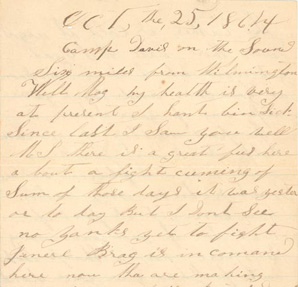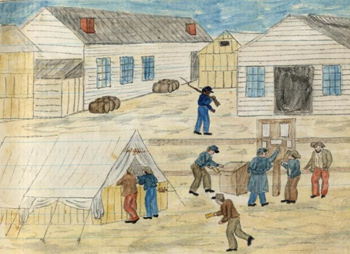 “Under the Rebel Flag: Life in Texas during the Civil War” is a new online exhibit available from the Texas State Library & Archives Commission. Even though it focuses is on a single state, teachers from across the country should be able to find material to use in their classrooms. The exhibit breaks down this period into nine sections that provide concise overviews of major topics and key events. Relevant primary sources, including historical images and letters (transcripts are available), are also in each section. One particularly interesting letter is in the Dissent section and provides an example of how one Texas community responded to an abolitionist in their midst – a Committee of Safety warned that he would face “Mob law” unless “[he left] our Country at once.” Be sure to check out the Texas State Library’s other online exhibits, including “Hard Road to Texas: Texas Annexation 1836-1845.”
“Under the Rebel Flag: Life in Texas during the Civil War” is a new online exhibit available from the Texas State Library & Archives Commission. Even though it focuses is on a single state, teachers from across the country should be able to find material to use in their classrooms. The exhibit breaks down this period into nine sections that provide concise overviews of major topics and key events. Relevant primary sources, including historical images and letters (transcripts are available), are also in each section. One particularly interesting letter is in the Dissent section and provides an example of how one Texas community responded to an abolitionist in their midst – a Committee of Safety warned that he would face “Mob law” unless “[he left] our Country at once.” Be sure to check out the Texas State Library’s other online exhibits, including “Hard Road to Texas: Texas Annexation 1836-1845.”
1
Mar
10
1
Mar
10
United States Colored Troops
Posted by Published in Civil War (1861-1865), Lesson Plans, Letters & Diaries Themes: Battles & Soldiers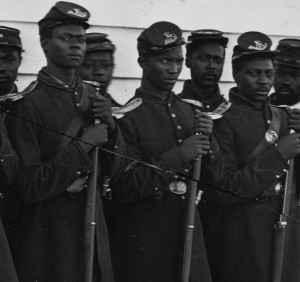 The National Archives has put together a great collection of materials highlighting the role that African-American soldiers played in the Civil War. Documents include letters highlighting the treatment of black prisoners of war by the Confederates, partial service records for Frederick Douglass’s sons, and partial service records for Sgt. William Carney, who received a Medal of Honor. No suggested grade levels were present on the website, so it is left up to individual teachers to create the level of difficulty appropriate for students.
The National Archives has put together a great collection of materials highlighting the role that African-American soldiers played in the Civil War. Documents include letters highlighting the treatment of black prisoners of war by the Confederates, partial service records for Frederick Douglass’s sons, and partial service records for Sgt. William Carney, who received a Medal of Honor. No suggested grade levels were present on the website, so it is left up to individual teachers to create the level of difficulty appropriate for students.
The activities included not only analyze the primary sources in terms of content with a provided worksheet, but ask students to synthesize and apply the information in one of four possible scenarios. Over all, the lesson activities are a bit weak when compared to the type of documents provided, yet under the heading ‘Further Research’ the lesson plan suggests students read and analyze Robert Lowell’s poem “Colonel Shaw and the Massachusetts’ 54th” (also known as “For the Union Dead,” available here) which is a great way to create an interdisciplinary lesson.
On the other hand, if one is looking for other ideas, the Civil War Preservation Trust offers a lesson plan on the United States Colored Troops, for grades six through eight. Using enlistment papers for a colored solider as well as two period illustrations, it guides teachers through several activities that ask students to describe, explain, and analyze information. The lesson plan is well thought out and can easily be supplemented with the documents made available by the National Archives.
19
Feb
10
Robert C. Caldwell Collection
Posted by sailerd Published in Civil War (1861-1865), Letters & Diaries Themes: Battles & Soldiers, Women & FamiliesThe Robert C. Caldwell Collection at East Carolina University offers an interesting perspective on life in the South during the Civil War. The collection consists primarily of Robert Caldwell’s letters to his wife between August 1863 and February 1865. He served with the 10th Battalion North Carolina Heavy Artillery, which remained in eastern North Carolina until they were sent to Georgia November 1864. Caldwell owned slaves, but by June 1864 he hoped that “this cruel war” would end and “let…Soldiers return home to our love ones in pece [sic].” In addition, this collection includes several letters from members of his extended family – Private Amzi Harris, who served in the 9th Mississippi Volunteer Regiment, wrote two letters in late 1861 that described Confederate operations in Florida. Mary W. Driskill, who lived on a farm in Georgia with her daughter, explained the hardships she faced while her husband served in the army.
17
Feb
10
The New South Newspaper (1862 -1866)
Posted by sailerd Published in Civil War (1861-1865), Historic Periodicals Themes: Battles & Soldiers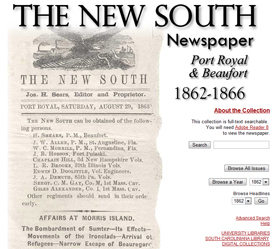 The Port Royal New South (1862-1866) offers an interesting perspective on life in the South Carolina lowcountry during the Civil War. The editors published the first issue of their weekly paper in March 1862, which was several months into the Union’s occupation of Port Royal. While it promised to “abstain from the discussion of exciting political topics,” the paper’s ultimate objective was “to strengthen the hands of the government and those who represent it.” This collection, which is available from the University of South Carolina, requires Adobe Reader in order to view any of the newspapers. A number of other interesting digital projects are also available.
The Port Royal New South (1862-1866) offers an interesting perspective on life in the South Carolina lowcountry during the Civil War. The editors published the first issue of their weekly paper in March 1862, which was several months into the Union’s occupation of Port Royal. While it promised to “abstain from the discussion of exciting political topics,” the paper’s ultimate objective was “to strengthen the hands of the government and those who represent it.” This collection, which is available from the University of South Carolina, requires Adobe Reader in order to view any of the newspapers. A number of other interesting digital projects are also available.
12
Feb
10
Reminiscences of My Life in Camp
Posted by Published in Civil War (1861-1865), Rare Books, Recent Scholarship Themes: Battles & Soldiers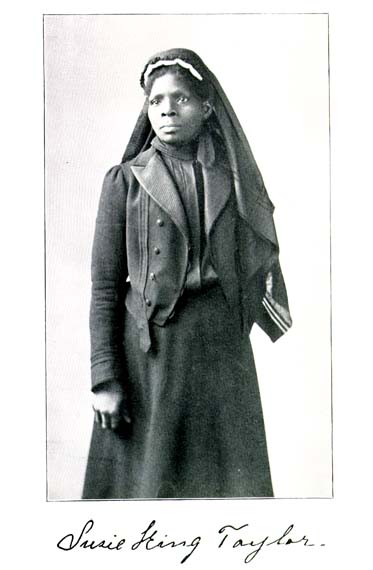 Susie King Taylor, born 1848, wrote a book in 1902 documenting her time spent enrolled as a laundress with the Union’s 1st South Carolina Volunteers, later named 33rd regiment of the United States Colored Troops, during the Civil War. Documenting the American South, an online resource at the University of North Carolina, has her entire book online.
Susie King Taylor, born 1848, wrote a book in 1902 documenting her time spent enrolled as a laundress with the Union’s 1st South Carolina Volunteers, later named 33rd regiment of the United States Colored Troops, during the Civil War. Documenting the American South, an online resource at the University of North Carolina, has her entire book online.
The book makes great use of primary sources, such as the General Order No. 1 of Lt. Colonel C.T. Trowbridge, commander of the regiment.
Taylor’s account is remarkably vivid outlining the struggles of African American Union soldiers fighting in the South. She described how “men and even women would sneer and molest them whenever they met them” while her regiment’s “brave men risked life and limb” to assist the citizens of Charleston, S.C. after the 1865 Confederate retreat and subsequent burning of the city.
This a great online primary resource for anyone interested in the life of African American soldiers during the Civil War. Camp life, battles, occupation, and officer descriptions are all intrinsically linked together in Taylor’s candid narrative of one of the definitive moments in our country’s history.
10
Feb
10
John Omenhausser, Civil War Sketchbook (1864-1865)
Posted by sailerd Published in Civil War (1861-1865), Images Themes: Battles & SoldiersConfederate John Jacob Omenhausser, who was captured in 1864 and spent about a year at a Union prison camp in Maryland, filled a sketchbook with over sixty paintings of camp life. The University of Maryland does not have all of Omenhausser’s paintings, but this one is the largest. Omenhausser, who served with the 46th Virginia Infantry, moved to Richmond after the war and worked as a candy maker. He had two children and later died in 1877. The University of Maryland has a number of other interesting digital collections available, including the “Sterling Family Papers” – which I highlighted in a previous post.
5
Feb
10
Lieutenant Cornelius C. Platter Diary (1864 – 1865)
Posted by sailerd Published in Civil War (1861-1865), Images, Letters & Diaries Themes: Battles & Soldiers Lieutenant Cornelius C. Platter’s diary (Nov. 1864 – April 1865), which is available from the Digital Library of Georgia, provides an account of his service with the 81st Ohio Infantry Volunteers as they marched through Georgia and the Carolinas with General William T. Sherman. This diary offers an interesting perspective on life as an officer throughout this campaign. “We are entirely cut off from communication with the north and are an isolated command,” as Platter wrote on November 13, 1864. One can view the entire diary at once or select a specific section through the table of contents. The project also includes a collection of all the images from George Barnard’s Photographic Views of the Sherman Campaign (1866).
Lieutenant Cornelius C. Platter’s diary (Nov. 1864 – April 1865), which is available from the Digital Library of Georgia, provides an account of his service with the 81st Ohio Infantry Volunteers as they marched through Georgia and the Carolinas with General William T. Sherman. This diary offers an interesting perspective on life as an officer throughout this campaign. “We are entirely cut off from communication with the north and are an isolated command,” as Platter wrote on November 13, 1864. One can view the entire diary at once or select a specific section through the table of contents. The project also includes a collection of all the images from George Barnard’s Photographic Views of the Sherman Campaign (1866).
2
Feb
10
Worth a Thousand Words: Photographs of Lincoln
Posted by Published in Civil War (1861-1865), Images, Lesson Plans Themes: Laws & Litigation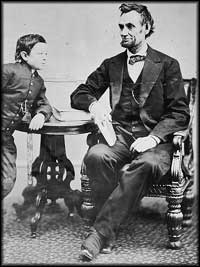 Written by Kaye Passmore and Amy Trenkle for the National Endowment for the Humanities, Picturing Lincoln is another Picturing America lesson plan. Using art as a medium to teach, students are asked to look at a photograph of Abraham Lincoln and make assessments. Later, students read a short biography of the president before exercising their creative skills in the forms of both poetry and artwork. The lesson plan is suggested for grades six through eight.
Written by Kaye Passmore and Amy Trenkle for the National Endowment for the Humanities, Picturing Lincoln is another Picturing America lesson plan. Using art as a medium to teach, students are asked to look at a photograph of Abraham Lincoln and make assessments. Later, students read a short biography of the president before exercising their creative skills in the forms of both poetry and artwork. The lesson plan is suggested for grades six through eight.
While the lesson plan offers an imaginative way for students to learn, one of the suggested extended activities, the interactive image assessment tool, allows students to become active learners. By clicking on various parts of Alexander Gardner’s February 5, 1865 photograph, students learn a fact before being encouraged to jot down any notes or questions they might have. While the activity is meant to be worked individually (with students emailing or printing out their responses), depending on individual class needs it could easily be adapted to be completed in small groups or as a whole.
26
Jan
10
Teaching Civil War Era –To Judge or Not To Judge
Posted by Matthew Pinsker Published in Civil War (1861-1865), General Opinion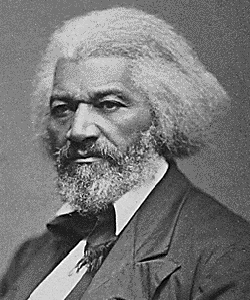 On Tuesday, January 26, 2010, I am beginning my Civil War Era history class with a quotation from Frederick Douglas at the top of my syllabus. “I shall never forget the difference,” the great activist claimed in 1894, “between those who fought for liberty and those who fought for slavery; between those who fought to save the Republic and those who fought to destroy it.” After surviving and escaping from slavery and after rising to become one of the nation’s great orators and moral visionaries, Douglass certainly earned the right to judge. But the question is … have I? Should a Civil War history professor lead off a syllabus and a semester with a comment like that one, which threatens to shatter the climate of historical objectivity and push students into making moral judgments about who was right or wrong during the Civil War era. Must they learn to condemn slavery and slaveholders, racism and racists –and most importantly, according to Douglass, treason and traitors– in order for the class to be a success? Or is it my job to encourage understanding about all sides in the conflict, regardless of how evil, cruel or stupid they might have been? I do believe in truth, but I also realize how dangerous it can be to turn historical study into an ersatz trial. My inclination is to accept an observation made several years ago by historian John Mack Faragher in the New York Times. “History is ultimately a moral art,” he told a reporter, “and it is about values. It is not merely about the collection of facts. It is about the way we put those facts together and the meaning we give them. Arguments about facts are arguments about meaning.” In other words, bring on the debate –as long as it comes rooted in evidence. But I wonder if students are really comfortable with that view or even know how to navigate historical texts and context while simultaneously arguing over values. Is it all too much, too soon? Has anyone had a classroom experience in any historical subject, but especially perhaps in the Civil War era, that might offer an answer, either as a model or as a warning?
On Tuesday, January 26, 2010, I am beginning my Civil War Era history class with a quotation from Frederick Douglas at the top of my syllabus. “I shall never forget the difference,” the great activist claimed in 1894, “between those who fought for liberty and those who fought for slavery; between those who fought to save the Republic and those who fought to destroy it.” After surviving and escaping from slavery and after rising to become one of the nation’s great orators and moral visionaries, Douglass certainly earned the right to judge. But the question is … have I? Should a Civil War history professor lead off a syllabus and a semester with a comment like that one, which threatens to shatter the climate of historical objectivity and push students into making moral judgments about who was right or wrong during the Civil War era. Must they learn to condemn slavery and slaveholders, racism and racists –and most importantly, according to Douglass, treason and traitors– in order for the class to be a success? Or is it my job to encourage understanding about all sides in the conflict, regardless of how evil, cruel or stupid they might have been? I do believe in truth, but I also realize how dangerous it can be to turn historical study into an ersatz trial. My inclination is to accept an observation made several years ago by historian John Mack Faragher in the New York Times. “History is ultimately a moral art,” he told a reporter, “and it is about values. It is not merely about the collection of facts. It is about the way we put those facts together and the meaning we give them. Arguments about facts are arguments about meaning.” In other words, bring on the debate –as long as it comes rooted in evidence. But I wonder if students are really comfortable with that view or even know how to navigate historical texts and context while simultaneously arguing over values. Is it all too much, too soon? Has anyone had a classroom experience in any historical subject, but especially perhaps in the Civil War era, that might offer an answer, either as a model or as a warning?
22
Jan
10
Sterling Family Papers
Posted by sailerd Published in Civil War (1861-1865), Letters & Diaries Themes: Battles & Soldiers, Women & Families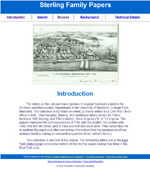 The University of Maryland has an interesting collection of sixty two letters from a family who lived in Maryland during the Civil War. This project consists primarily of Tillie Farquhar Sterling’s correspondence with her mother, which can provide an interesting look into daily life in Maryland between 1862 and 1864. Other letters in the collection include those written by Tillie’s husband, who was an officer in the US army. In addition, the site has a short essay that provides more information on the family’s history. The New York State Library also has a collection of letters from this family, although they have not been digitized yet.
The University of Maryland has an interesting collection of sixty two letters from a family who lived in Maryland during the Civil War. This project consists primarily of Tillie Farquhar Sterling’s correspondence with her mother, which can provide an interesting look into daily life in Maryland between 1862 and 1864. Other letters in the collection include those written by Tillie’s husband, who was an officer in the US army. In addition, the site has a short essay that provides more information on the family’s history. The New York State Library also has a collection of letters from this family, although they have not been digitized yet.
